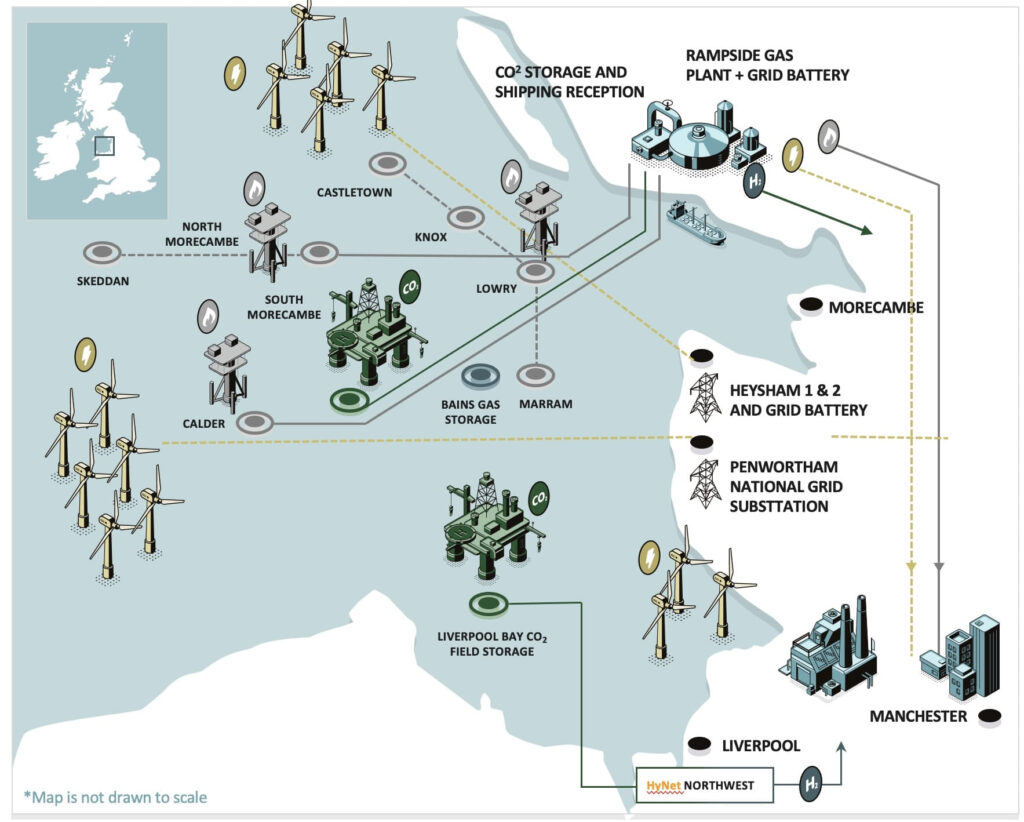Copyright offshore-energy

With energy storage capacity growth in mind, EnergyPathways, the England-based energy transition-focused player, is moving forward with its expansion aspirations by pursuing new storage license applications for its proposed large-scale offshore wind-powered energy storage project in the East Irish Sea. EnergyPathways has decided to submit new hydrogen and natural gas storage license applications for its flagship Marram Energy Storage Hub (MESH) project, following the receipt of consent from the North Sea Transition Authority (NSTA) to apply for such licenses in the East Irish Sea. As a result, the UK player intends to submit one or more new gas storage applications later this month to support its expansion plans for this large-scale long-duration energy storage (LDES) and decarbonization project. This step is perceived to further underpin the company’s vision to grow the project into one of the UK’s largest integrated energy storage and decarbonization hubs. Ben Clube, Chief Executive Officer of EnergyPathways, commented: “We are delighted to advance our plans to apply for new hydrogen and natural gas storage licences from the NSTA. This follows the Secretary of State’s formal confirmation that our MESH project is a project of national significance – a powerful signal that reinforces our confidence in the UK investment environment for energy transition projects such as MESH. “It further highlights MESH’s potential to supply more affordable energy to Britain’s consumers and make a material contribution to the nation’s Clean Power 2030, energy security, and net zero ambitions. By developing MESH for large scale LDES, low-carbon flexible power and new hydrogen production industries, MESH is firmly aligned with the government’s energy priorities.” While explaining that its nominated area for these new hydrogen and natural gas storage licenses covers an area of salt cavern storage potential around four times greater than it had previously applied for, the firm elaborated that these applications, if successful, will provide opportunity for expanded salt cavern energy storage capacity and the significant scalable expansion of the MESH project as a major integrated LDES and low-carbon flexible power system. The move follows the direction issued in September 2025 by Ed Miliband, UK’s Secretary of State for Energy Security and Net Zero, confirming that the key elements of the integrated MESH development should be treated as a project of national significance under the 2008 Planning Act, underscoring its potential critical role in the country’s long-term energy security and net zero strategy and the supply of more affordable energy to British consumers. Clube underscored: “We are now accelerating project delivery alongside our Tier 1 partners, including Siemens Energy, Hazer Group in conjunction with KBR Inc., Wood plc, Costain plc, and Zenith Energy. In parallel we will progress our applications for the consents and approvals required to bring this landmark project into operation. “If the company is successful with these new hydrogen and natural gas storage licence applications, EnergyPathways will secure an area of salt cavern storage potential around four times greater than that it had previously sought.” MESH, which is expected to provide a secure and dependable supply of affordable low-carbon energy for the UK market for over 25 years, comprises: large-scale LDES, flexible low-carbon power capacity, and low-carbon hydrogen and graphite production with the potential to branch into low-carbon ammonia production. Designed to capture and store curtailed offshore wind power in offshore salt caverns as compressed air, the MESH energy storage system combines associated large-scale hydrogen, thermal and natural gas storage capacity in salt caverns, as well as gas storage in the Marram gas field clastic reservoirs. During periods of low renewable energy availability, the LDES stored energy resources will be utilised to generate low-carbon flexible power for the UK’s grid via compressed air expansion, thermal energy and hydrogen-compatible gas turbine systems to generate electricity. The project will connect its LDES integrated storage system using existing infrastructure to the UK grid and nearby offshore wind capacity to help harness value from the UK’s wind power. The MESH facility will also produce affordable low-carbon hydrogen using a methane pyrolysis technology to which EnergyPathways has exclusive rights of use within the UK. According to the company, the hydrogen can be used to further decarbonize the project’s flexible power generation system using its hydrogen-compatible gas turbine system. The produced hydrogen can also be stored in MESH hydrogen storage or supplied into the UK’s emerging Project Union hydrogen network, further contributing to emissions reduction across the broader UK energy system. In addition, hydrogen has the potential to be used to produce low-carbon ammonia at bolt-on facilities. The company identifies a by-product of the MESH hydrogen production facility as a high-grade form of synthetic graphite, seen as a critical mineral for energy transition. As the MESH project is targeted to be operational by 2030, subject to government approvals and financing, to contribute to Britain’s 2030 clean power ambitions, EnergyPathways aims to play its role in supporting the government in accelerating the UK’s energy transition.



